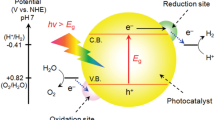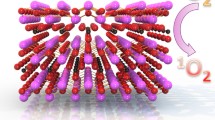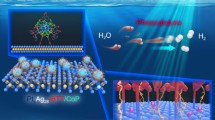Abstract
Heterojunctions modulated internal electric field (IEF) usually result in suboptimal efficiencies in carrier separation and utilization because of the narrow IEF distribution and long migration paths of photocarriers. In this work, we report distinctive bismuth oxyhydroxide compound nanorods (denoted as BOH NRs) featuring surface-exposed open channels and a simple chemical composition; by simply modifying the bulk anion layers to overcome the limitations of heterojunctions, the bulk IEF could be readily modulated. Benefiting from the unique crystal structure and the localization of valence electrons, the bulk IEF intensity increases with the atomic number of introduced halide anions. Therefore, A low exchange ratio (~10%) with halide anions (I–, Br–, Cl–) gives rise to a prominent elevation in carrier separation efficiency and better photocatalytic performance for benzylamine coupling oxidation. Here, our work offers new insights into the design and optimization of semiconductor photocatalysts.
Similar content being viewed by others
Introduction
In recent years, light-powered catalytic organic synthesis has garnered increasing research interests. During photocatalysis, the separation of electron-hole pairs within the semiconductor catalysts, combined with the following energy transfer processes, can readily generate a large amount of highly active species (such as radicals and singlet oxygen1,2,3,4. Notably, these active species could, under green and mild conditions, participate in a variety of organic reactions, including hydrogenation5,6, epoxidation7,8, alcohol oxidation9,10, selective oxidation of aromatic compounds11,12, and even some reactions that are rather challenging in thermal catalysis. Yet still, currently for heterogeneous photocatalysts, there exist the common issues of rapid recombination of photocarriers and the resulting low efficiency of carrier separation and utilization, which would hamper the high-performance catalysis of organic reactions, and thus their applications have so far been limited primarily to environment-related aspects such as degradation of organics, air purification and water photolysis13,14,15,16,17. A strategy extensively adopted to boost the carrier separation efficiency is to construct composite materials featuring heterojunctions, in which the internal electric field (IEF), resulting from the different band structures at the interface, is expected to facilitate the carrier separation and migration18,Full size image
The high-angle annular dark-field scanning transmission electron microscopy (HAADF-STEM) image and the energy-dispersive X-ray (EDX) map** results (Fig. 2c–e) confirm that in the BOH NRs, the Bi and O elements are evenly distributed. The selected-area electron diffraction (SAED) pattern (Fig. 2f) and high-resolution TEM (HRTEM) image (Fig. 2g) reveal that each BOH NR is of single crystallinity and has well-ordered lattice fringes. The hydrolysis of Bi(NO3)3·5H2O can yield multiple products including Bi5O7(NO3) or basic bismuth nitrates (Bi6O6(OH)2(NO3)4·2H2O, Bi6O5(OH)3(NO3)5·3H2O, Bi2O2(OH)(NO3), etc.). All of these products are made of backbones of [Bi–O] layers, with anion layers intercalated in between; the main differences are the arrangement of Bi and O atoms in [Bi–O] layers, and the types and amounts of anions (such as NO3– and OH–)29,30,31. We performed aberration-corrected HAADF-STEM (AC HAADF-STEM) with atomic resolution. Supplementary Fig. 2 shows that the BOH NR is composed of ~10 ordered layers arranged in parallel, each layer with a thickness of ~1 nm. In Fig. 2h, it can be clearly observed that each layer has two arrays of Bi atoms (Bi atoms appear as bright dots in the image, whereas O atoms are barely observable owing to the small atomic number), and the inter-array spacing is 0.27 nm, which is identical to that within the [Bi2O2]2+ layer of the known compound Bi2O2(OH)(NO3) (that is, the distance between two neighboring red balls in Fig. 2h) (for the two-dimensional structure of Bi2O2(OH)(NO3), see Supplementary Fig. 3). The results above confirm that our BOH NRs have a layered [Bi2O2]2+ structure similar to that in Bi2O2(OH)(NO3), and the interlayer channels are openly exposed. The alternating [Bi2O2]2+ and anion layers are stacked via van der Waals interaction, forming a layered Sillenite structure; between the neighboring [Bi2O2]2+ and anion layers exists a perpendicular IEF, which could facilitate the carrier separation32.33. In addition, the IEF is also perpendicular to the normal of the exposed facets of BOH, and thus shortens the migration path for photocarriers, which is conducive to the transport and separation of chargesFull size image








